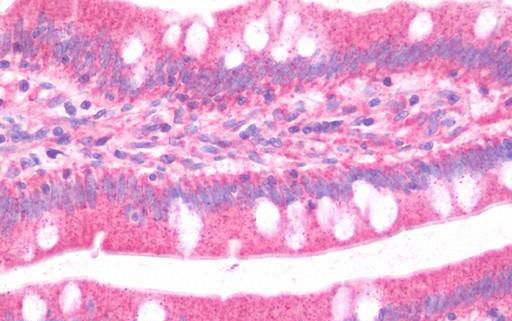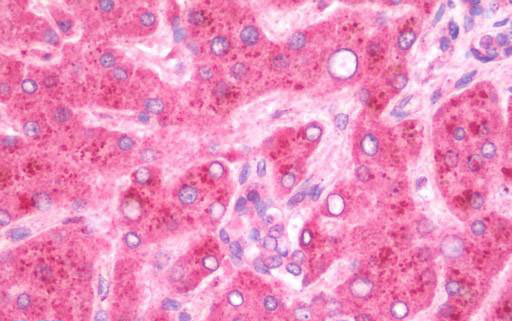GBP5 Antibody
Rabbit Polyclonal Antibody
- SPECIFICATION
- CITATIONS
- PROTOCOLS
- BACKGROUND

Application
| WB, IHC-P |
|---|---|
| Primary Accession | Q96PP8 |
| Other Accession | 115362 |
| Reactivity | Human |
| Host | Rabbit |
| Clonality | Polyclonal |
| Isotype | IgG |
| Calculated MW | 66617 Da |
| Dilution | IHC-P (5 µg/ml), WB (1:500 - 1:3000), |
| Gene ID | 115362 |
|---|---|
| Other Names | GBP5, GBP-TA antigen, GTP-binding protein 5, Guanylate binding protein 5, Guanylate-binding protein 5, GBP-5 |
| Target/Specificity | Human GBP5 |
| Reconstitution & Storage | 0.1 M Tris-glycine, pH 7, 20% Glycerol, 0.01% Thimerosal. Aliquot and freeze at -20° C. Avoid freeze-thaw cycles. |
| Precautions | GBP5 Antibody is for research use only and not for use in diagnostic or therapeutic procedures. |
| Name | GBP5 {ECO:0000303|PubMed:20180847, ECO:0000312|HGNC:HGNC:19895} |
|---|---|
| Function | Interferon (IFN)-inducible GTPase that plays important roles in innate immunity against a diverse range of bacterial, viral and protozoan pathogens (By similarity). Hydrolyzes GTP, but in contrast to other family members, does not produce GMP (PubMed:20180847). Following infection, recruited to the pathogen-containing vacuoles or vacuole- escaped bacteria and acts as a positive regulator of inflammasome assembly by promoting the release of inflammasome ligands from bacteria (By similarity). Acts by promoting lysis of pathogen-containing vacuoles, releasing pathogens into the cytosol (By similarity). Following pathogen release in the cytosol, promotes recruitment of proteins that mediate bacterial cytolysis: this liberates ligands that are detected by inflammasomes, such as lipopolysaccharide (LPS) that activates the non-canonical CASP4/CASP11 inflammasome or double- stranded DNA (dsDNA) that activates the AIM2 inflammasome (By similarity). As an activator of NLRP3 inflammasome assembly: promotes selective NLRP3 inflammasome assembly in response to microbial and soluble, but not crystalline, agents (PubMed:22461501). Independently of its GTPase activity, acts as an inhibitor of various viruses infectivity, such as HIV-1, Zika and influenza A viruses, by inhibiting FURIN-mediated maturation of viral envelope proteins (PubMed:26996307, PubMed:31091448). |
| Cellular Location | Cytoplasmic vesicle membrane {ECO:0000250|UniProtKB:Q8CFB4}; Lipid-anchor, GPI-like-anchor. Golgi apparatus membrane; Lipid-anchor. Cytoplasm |
| Tissue Location | Expressed in peripheral blood monocytes (at protein level). |

Thousands of laboratories across the world have published research that depended on the performance of antibodies from Abcepta to advance their research. Check out links to articles that cite our products in major peer-reviewed journals, organized by research category.
info@abcepta.com, and receive a free "I Love Antibodies" mug.
Provided below are standard protocols that you may find useful for product applications.
Background
Stimulates the NLRP3 inflammasome assembly upon bacterial challenge.
References
Avdalovic A.,et al.Submitted (JUL-2000) to the EMBL/GenBank/DDBJ databases.
Fellenberg F.,et al.J. Invest. Dermatol. 122:1510-1517(2004).
Clark H.F.,et al.Genome Res. 13:2265-2270(2003).
Ota T.,et al.Nat. Genet. 36:40-45(2004).
Mural R.J.,et al.Submitted (SEP-2005) to the EMBL/GenBank/DDBJ databases.
If you have used an Abcepta product and would like to share how it has performed, please click on the "Submit Review" button and provide the requested information. Our staff will examine and post your review and contact you if needed.
If you have any additional inquiries please email technical services at tech@abcepta.com.













 Foundational characteristics of cancer include proliferation, angiogenesis, migration, evasion of apoptosis, and cellular immortality. Find key markers for these cellular processes and antibodies to detect them.
Foundational characteristics of cancer include proliferation, angiogenesis, migration, evasion of apoptosis, and cellular immortality. Find key markers for these cellular processes and antibodies to detect them. The SUMOplot™ Analysis Program predicts and scores sumoylation sites in your protein. SUMOylation is a post-translational modification involved in various cellular processes, such as nuclear-cytosolic transport, transcriptional regulation, apoptosis, protein stability, response to stress, and progression through the cell cycle.
The SUMOplot™ Analysis Program predicts and scores sumoylation sites in your protein. SUMOylation is a post-translational modification involved in various cellular processes, such as nuclear-cytosolic transport, transcriptional regulation, apoptosis, protein stability, response to stress, and progression through the cell cycle. The Autophagy Receptor Motif Plotter predicts and scores autophagy receptor binding sites in your protein. Identifying proteins connected to this pathway is critical to understanding the role of autophagy in physiological as well as pathological processes such as development, differentiation, neurodegenerative diseases, stress, infection, and cancer.
The Autophagy Receptor Motif Plotter predicts and scores autophagy receptor binding sites in your protein. Identifying proteins connected to this pathway is critical to understanding the role of autophagy in physiological as well as pathological processes such as development, differentiation, neurodegenerative diseases, stress, infection, and cancer.




